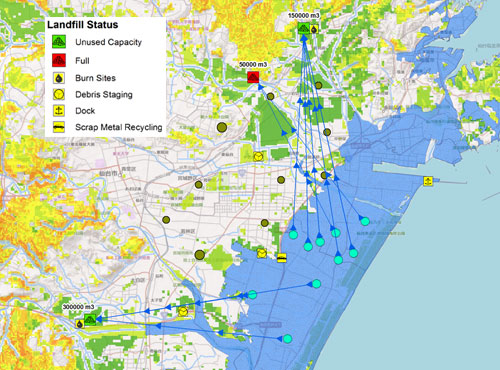Off the Map
GIS Explained
“ArcGIS is similar to information modeling, and everyone is doing that now,” says Keith Besserud, referring to the growing use among architects of three-dimensional building information modeling (BIM). He suggests the transition to a full GIS platform may be easier for the industry than the move to BIM. An architect in the Chicago office of Skidmore Owings & Merrill (SOM), Besserud directs the firm’s BlackBox group that focuses on research-oriented computational design. The group is creating a data model of Chicago’s core starting with a simple 3-D Studio Max model of the city’s geometry. Although the model hasn’t been developed in ArcGIS, the group is using a GIS-based approach. Besserud intends to layer in data obtained from public sources and build up an intelligent database that will include information describing infrastructure and buildings. The ultimate goal is a tool that could be used to test development options and simulate their effect on municipal energy, water, and waste systems in real time. He compares the potential of GIS to that of developments in neuroscience that digitally display the brain’s responses to certain external stimulants. “We don’t have those kinds of tools for analyzing cities,” he says.
| Esri – Disaster Response Mapping, Japan's Northeast Coast |
 |
Disaster Planning and Debris Classification Image courtesy of Esri |
Terry Bennett, senior industry program manager for civil engineering and planning at Autodesk, considers GIS to be any software that anchors objects in the real world within a model. “There’s not much that doesn’t benefit from a geospatial understanding,” Bennett says.
At its core, GIS is a digital representation of the earth that can be viewed at a variety of scales and depths. Like the city grid, GIS can be used to spatially plot coordinates. Or it can be used to locate specific objects and tie intangible information, such as demographics, to a representation of a site, establishing a visually simple way to describe the spatial relationships among objects, people, and events. In addition, global positioning systems (GPS) embedded in devices like smartphones have made it easier for anyone to tag site-specific data in web-based applications like Facebook or Google Maps. The developing interface between GIS platforms and other software, like Google SketchUp or Autodesk’s Infrastructure Modeler or Revit, could one day allow architects to explore all facets of a design within a GIS context.
The information mapped into GIS software is becoming more reliable as organizations and government agencies invest more resources in preparing data sets. However, most GIS experts recommend verification through a commissioned survey, photographic documentation, or some other method—especially when extreme accuracy is required. Bennett suggests that high-level, less-precise GIS modeling is best used as an early design phase decision-making tool. Deploying GIS in this way can help project teams avoid problems that might arise in later stages of the design process.
GIS platforms can be thought of in two ways—as vector files or raster files. Vector data files are lines, curves, and nodes that can form more specific information sets. Three-dimensional representations of buildings and roads are typically vector files developed in other software, such as AutoCAD. A raster data file consists of grid cells, where each grid is coded with a specific set of data.
There are a variety of ways these data are collected in GIS software. Light Detection and Ranging (LIDAR) is a method that relies on lasers to survey a site, either from the ground or from a plane. The most common basis is Landsat imagery, captured by a NASA satellite, which forms the backbone of the Google Earth software, as well as others. NASA’s World Wind project layers additional imagery onto this data set to create three-dimensional depictions of the earth’s surface (as well as the moon, Jupiter, and several other planets). The benefit of using NASA’s information is that it’s open-source, a product of the Open Geospatial Consortium (OGC) movement within the GIS industry. The goals of the OGC are to make data sets publicly available and to standardize file types across different platforms.
One outgrowth of the open-source effort is the expanding number of online repositories, such as geocommons.com and PostGIS.org, where users can upload maps and data sets and make them available to other users. According to Shannon McElvaney, an Esri project manager, these sites offer great crowd-sourcing potential. He points to the maps generated and posted online by the general public in the aftermath of the Japanese quake and tsunami with information about aftershocks and links to geo-located video and images. “GIS is a way to document and publish a huge body of local knowledge,” he says.
Dan Getman, the geospatial team leader in the Strategic Energy Analysis Center at the National Renewable Energy Laboratory (NREL) in Golden, Colorado, is a proponent of open-source software and publicly available data sets, both of which he relies on to create renewable energy maps with his research team. NREL has a tool called IMBY Solar that allows anyone to draw a solar photovoltaic array on an aerial image of a site and instantly calculate its potential for energy generation. The engine running that calculation is hosted on external servers and the entire application is web based. Getman sees the move to cloud computing as one of the most important GIS developments. It allows users who may not have large amounts of computing power access to massive quantities of data. “GIS is no longer something you do on your desktop,” he says.









